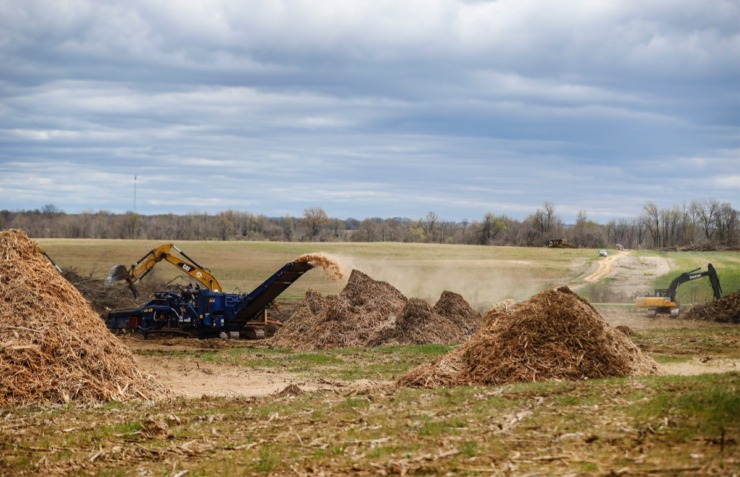This article was originally published in The Daily Memphian.
While Ford Motor Co.’s planned Blue Oval City isn’t scheduled to begin production until 2025, community leaders and Mid-South businesses are asking questions now about smart growth.
U.S. Rep. David Kustoff hosted a panel Wednesday, April 13, in Brownsville, Tennessee, about 15 miles from the Megasite of West Tennessee, where Ford plans to build its $5.6 billion auto manufacturing campus.
During the panel, Kustoff asked participants how they would like the communities in West Tennessee to look following Ford’s investment.
“I look at the census that just came out, and a lot of West Tennessee was either stagnant or shrunk,” he said during an interview following the panel. “That won’t be the case 10 years from now.”
The project, which is expected to bring about 6,000 direct jobs to the region, was called the “single-largest investment in Tennessee history” by Gov. Bill Lee during a formal announcement last year.
Still, questions remain about how West Tennessee will pull off the potentially transformative project and how a largely rural Haywood County will grow to meet its evolving needs.
“Ford Motor Company’s investment in the Megasite will bring in thousands of jobs and will reshape West Tennessee’s economy for generations to come,” Kustoff said.
“Residential and commercial real estate development will increase as retail stores, restaurants, medical facilities and other businesses move in to meet a rise in demand. Today’s meeting was to ensure that as West Tennessee’s economy grows, our local leaders can communicate and work together to promote smart growth and responsible development in our region.”
There’s still time
While Ford won’t produce its all-electric F-150 Lightning pickup truck at Blue Oval City for another three years, the project is rapidly moving forward, according to Clay Bright, CEO of the Megasite Authority of West Tennessee. Bright participated in Wednesday’s panel.
In March, Ford CEO Jim Farley tweeted that work had begun at the site.
Aside from the Megasite itself, property values around Haywood County are already starting to soar in anticipation of related development projects.
And while momentum may appear to be building quickly, Brooxie Carlton — Tennessee Department of Economic and Community Development (TNECD) Assistant Commissioner of Community and Rural Development — said there is still time for communities in West Tennessee to plan strategically and effectively.
“They have a chance to take some time to envision what they want their community to be and then figure out the steps they need to take this year and the steps they need to take over the next three years to make sure their community gets to that point,” Carlton said.
Specifically, Carlton said attention should be given to where water and sewer architecture will be built. Communities like Brownsville and Stanton should also consider what types of retail they want to see expanded into their region.
Mark Herbison, president and CEO of economic development firm HTL Advantage, said Wednesday he has already seen a “wave of activity” in Brownsville, including possibly three new hotels and multiple restaurant options.
Development opportunities are growing all across West Tennessee, but Herbison stressed the importance of taking the time to evaluate all the possibilities.
“There are residential developers all over the region looking in places like Covington, Munford, Atoka, Somerville to build new subdivisions and neighborhoods, but we’re taking our time,” Herbison said.
Herbison said Haywood County is working to complete a study based on population projections and what needs to be accomplished to maximize potential growth based on population change.
Issues to consider as these rural communities experience unprecedented growth includes a need for more public services like schools, fire and police stations, as well as public utilities like waste water management upgrades.
“So that’s really what these meetings are about,” Herbison said. “Don’t be in such a big hurry that you don’t plan what you’re doing because we do have time. (Ford) is not going to open the doors until 2025 and they’re not going to start hiring people until 2024, so we have time to get ready.”
HTL Advantage serves Haywood, Tipton and Lauderdale counties.
The years to come
While Memphis-based Fogelman Properties doesn’t have real estate interest in Haywood County, president Mark Fogelman said his experiences in regions like Chattanooga following Volkswagen’s investment could be used to gauge what could happen in West Tennessee.
“We typically see a lot of well-grounded excitement around the announcement, and it’s usually followed by a lot of real estate investment in the immediate areas around the site,” Fogelman said. “By the time it’s three or four years down the road and you’ve actually got the property built, there’s been many price surges and decreases. It’s gone up and down.”
Fogelman Properties also has assets in the communities surrounding BMW’s automobile plant in South Carolina.
While Fogelman said the initial announcement can drive a lot of attention, the true development story plays out over 10 to 15 years.
“As much as it’s about the people who will be working for Ford, the story is as much about the whole sense of change that will take place around the facility and the surrounding communities,” Fogelman said. “Typically, we see that the suppliers to the manufacturers can end up having a multiple of the number of employees as the actual manufactures themselves, and that usually follows in the years after. It’s just incredibly exciting.”
Despite the potential for positive growth, Mike Aiken, Fogelman’s senior vice president of investments, says smart urban planning is still key to success.
“When you take all of the offices and cluster them in one area, and then all of the retail is clustered in another area, with single and multi-family housing clustered in yet another area, that has proven time and time again to be a bad urban planning tool,” Aiken said.
“Not everybody is going to want to walk or take a form of public transportation, but I think there will be a decent number of people, especially the younger cohort, that would love that,” he said. “If you can design the facilities where you can get, not just to your job and get back, but to your house and your shopping and leisure activities, those are the areas that have really done well.”
This article was originally published in The Daily Memphian.
 Fogelman LivingDiscover the Fogelman Difference
Fogelman LivingDiscover the Fogelman Difference